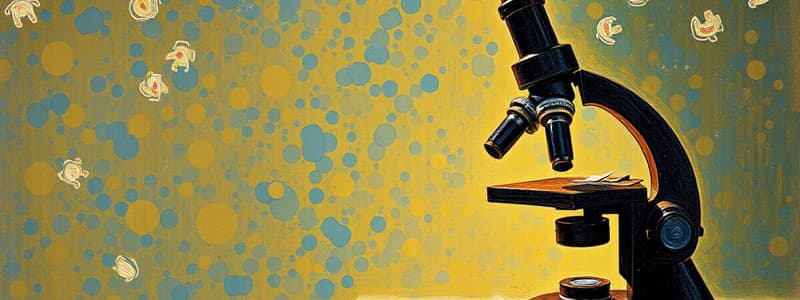Podcast
Questions and Answers
A microscope is an optical instrument used for viewing very small objects, such as mineral samples or animal and plant ______.
A microscope is an optical instrument used for viewing very small objects, such as mineral samples or animal and plant ______.
cells
The first term microscope was used by Giovanni ______ to refer to the compound microscope of Galilei.
The first term microscope was used by Giovanni ______ to refer to the compound microscope of Galilei.
Faber
Robert Hooke coined the term ‘______’ when he observed cells in cork.
Robert Hooke coined the term ‘______’ when he observed cells in cork.
cells
Matthias ______ concluded that all plants are made of cells.
Matthias ______ concluded that all plants are made of cells.
Antonie van Leeuwenhoek was the first to see ______ cells using his own single lens microscope.
Antonie van Leeuwenhoek was the first to see ______ cells using his own single lens microscope.
The phrase ‘Omnis cellula e cellula’ was proposed by Rudolf ______ to mean that all cells are from pre-existing cells.
The phrase ‘Omnis cellula e cellula’ was proposed by Rudolf ______ to mean that all cells are from pre-existing cells.
The ______ Microscope uses multiple lenses to magnify the image of small specimens.
The ______ Microscope uses multiple lenses to magnify the image of small specimens.
Robert Brown discovered the ______, a vital component within the cell.
Robert Brown discovered the ______, a vital component within the cell.
Flashcards are hidden until you start studying
Study Notes
Microscope Overview
- Optical instrument for viewing small objects like cells and mineral samples, typically magnified hundreds of times.
- Two main types: Simple Microscope and Compound Microscope.
Simple Microscope
- Composed of a single biconvex lens, commonly known as a magnifying glass.
- For viewing, objects are placed between the optic center and the focus; produces an erect, virtual, and magnified image.
Compound Microscope
- Involves multiple lenses to achieve higher magnification and clearer images.
- Significant historical advancements leading to its development.
Historical Development of the Microscope
- 1590: Hans Janssen and Zacharias Janssen created a microscope with multiple lenses.
- 1609: Galileo Galilei invented a compound microscope using both convex and concave lenses.
- 1625: Giovanni Faber coined the term "microscope" for Galilei's instrument.
- 1665: Robert Hooke introduced the term "cell" in his work "Micrographia," identifying plant cells as an early microscopy pioneer.
- 1676: Antonie van Leeuwenhoek observed living cells using his single-lens microscope, studying blood cells, yeast, and insects.
Modern Microscope
- Introduction of advanced versions like the Transmission Electron Microscope (TEM) enhances observation at the cellular level.
Cell Theory
- 1665: Robert Hooke first observed and named "cells" in cork.
- 1827-33: Robert Brown observed Brownian motion and discovered the nucleus.
- 1838: Matthias Schleiden determined that all plants are composed of cells.
- 1839: Theodor Schwann concluded that all animals consist of cells.
- 1855: Rudolf Virchow proposed "Omnis cellula e cellula," stating all cells arise from pre-existing cells.
- Formally established in 1839, the Cell Theory is a foundational principle in biology, emphasizing that cells are the basic unit of life.
Studying That Suits You
Use AI to generate personalized quizzes and flashcards to suit your learning preferences.




